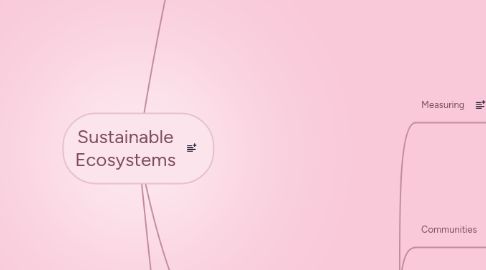
1. Sustainability
1.1. Components of an Ecosystem
1.1.1. Abiotic
1.1.1.1. Earth's Spheres
1.1.1.1.1. Lithospheres
1.1.1.1.2. Hydrosphere
1.1.1.1.3. Atmosphere
1.1.2. Biotic
1.1.2.1. Earth's Spheres
1.1.2.1.1. Biosphere
1.2. Nutrient Cycles
1.2.1. Water Cycle
1.2.2. Nitrogen Cycle
1.2.2.1. Nitrogen Fixation
1.2.2.1.1. Nitrogen Fixing Bacteira
1.2.2.1.2. Lightning
1.2.2.1.3. Haber-Process
1.2.2.2. Types of Nitrogen
1.2.2.2.1. Nitrate
1.2.2.2.2. Ammonium
1.2.2.2.3. Ammonia
1.2.3. Carbon Cycle
1.2.3.1. Photosynthesis
1.2.3.1.1. Cellular Respiration
1.2.3.2. Cellular Respiration
1.2.3.2.1. Photosynthesis
1.2.3.3. Human Interaction
1.2.3.3.1. Greenhouse Effect
1.2.3.3.2. Greenhouse Gases
1.2.4. Phosphorus Cycle
1.2.4.1. Human Interaction
1.2.4.1.1. Negative Effects of Agricultural Fertilizers
1.3. Trophic Levels
1.3.1. Producers
1.3.2. Consumers
1.3.3. Detritivores
1.3.4. Carnivores
1.3.5. Herbivores
1.3.6. Omnivores
1.3.7. Energy Flow
1.3.7.1. Sun
1.3.7.2. Primary Producer
1.3.7.2.1. Herbivore
1.3.7.3. Primary Consumer
1.3.7.3.1. Carnivores
1.3.7.3.2. Omnivores
1.3.7.4. Secondary Comsumer
1.3.7.4.1. Carnivores
1.3.7.4.2. Omnivores
1.3.7.5. Tertiary Consumer
1.3.7.5.1. Carnivores
1.3.7.5.2. Omnivores
1.4. Trophic Efficiency
1.4.1. Reasons for Loss
1.4.1.1. Metabolic Functions
1.4.1.2. Heat
1.4.1.3. Waste Production
1.5. Bioaccumilation
1.6. Biomagnification
2. Ecological Niches
2.1. Population
2.1.1. Exponential Growth
2.1.2. Limiting Factors
2.1.3. Carrying Capacity
2.1.3.1. Human Impact
2.1.3.1.1. Urban Sprawl
2.2. Interactions Between Species
2.2.1. Predation
2.2.1.1. Bottom-up Population Regulation
2.2.1.2. Top-down Population Regulation
2.2.2. Competition
2.2.2.1. Competition Causes
2.2.2.1.1. Lower Birth Rates
2.2.2.1.2. Narrowing of Niches
2.2.3. Symbiosis
2.2.3.1. Mutualism
2.2.3.2. Parasitism
2.2.3.3. Commensalism
2.3. Human Niches & Populations
2.3.1. Ecological Footprints
2.3.2. Ecological Services
2.3.2.1. Examples
2.3.2.1.1. Forests
2.3.2.1.2. Insects
2.3.2.1.3. Migratory Birds
2.3.2.2. Human Influence
2.3.2.2.1. Ecotourism
2.3.3. Human Niche
2.3.3.1. Unknown Carrying Capacity
2.3.3.2. Narrow Niche
3. Biodiversity
3.1. Measuring
3.1.1. Biodiversity Hotspots
3.1.2. Methods
3.1.2.1. Canopy Fogging
3.1.2.2. Transect Sampling
3.1.2.3. Quadrat Sampling
3.1.2.4. Netting
3.2. Communities
3.2.1. Dominet Species
3.2.2. Keystone Species
3.2.2.1. Captive Breeding
3.2.3. Ecosystem Engineers
3.3. Threats
3.3.1. Habitat Loss
3.3.2. Alien Species
3.3.2.1. Invasive Species
3.3.2.2. Introduction
3.3.2.2.1. Deliberate Introduction
3.3.2.2.2. Accidental Introduction
3.3.3. Overexplotation
3.3.3.1. Mass Extinction
3.3.3.2. Background Extinction
3.4. Restorative Ecology
3.4.1. Environmental Rehabilitation
3.4.2. Methods of Restoration
3.4.2.1. Reforestation
3.4.2.2. Wetland Restoration
3.4.2.3. Controlling Alien Species
3.4.2.3.1. Biocontrol
3.4.2.3.2. Chemical Control
3.4.2.4. Bioremediation
3.4.2.5. Bioaugmentation
